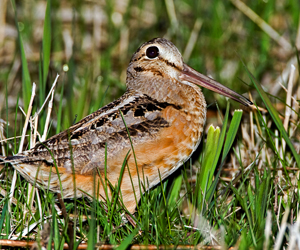|
The Timberdoodle Skydance |
|
|
Woodcocks feed in young forests (unlike other shorebirds). Their camouflage coloring makes them difficult to see as they quietly go about their business hidden in the leaf litter. They take slow steps, using their long, flexible beaks to probe the soil for their favorite food: earthworms. American Woodcock display grounds are usually open fields that are near a forested area and open clearings in the forest or prairie-savannahs are good places to look. Woodcocks are beautiful and secretive wading birds in need of protection as habitat loss has caused a decline in their population. Local birders often know about these display grounds, so contact your local birding club to find out where they are — or go out exploring on your own!
The best way to see Woodocks displaying is to get to the display area just before sunset. As the sun dips towards the horizon, you should start to hear a loud, nasally buzzing sound: PEENT! That’s a male woodcock calling! They call from the ground, emitting a single PEENT once every few seconds. After a few minutes of this, you should see a football-shaped bird rising high into the sky, accompanied by a twittering sound. They fly fast! The male woodcock will make several circles, wheeling high in the sky. The twittering sound is not made by the woodcock’s voice, but by his wings. Several primary feathers are stiff and thin and end in a club-like projection. As the woodcock pumps his wings, the force of the wind over these stiff feathers creates the twittering sound.
After circling the sky, the male woodcock descends towards the ground in a zig-zag. He will land almost exactly where he started, and will start the display all over again. The display will go on until just after dark, and will begin again in the early morning. The legendary conservationist Aldo Leopold called this the “sky dance”. Here is a quote from his famous book, A Sand County Almanac. “Up and up he goes, the spirals steeper and smaller, the twittering louder and louder, until the performer is only a speck in the sky. Then, without warning, he tumbles like a crippled plane, giving voice in a soft liquid warble that a March bluebird might envy. At a few feet from the ground he levels off and returns to his peenting ground, usually to the exact spot where the performance began, and there resumes his peenting.” |
